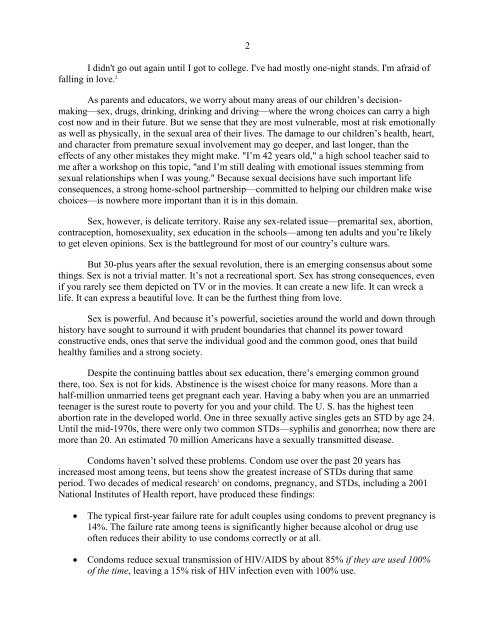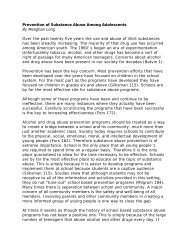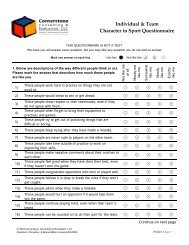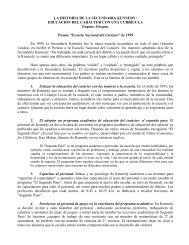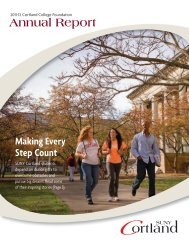How to Talk to Kids About Sex, Love, and Character
How to Talk to Kids About Sex, Love, and Character
How to Talk to Kids About Sex, Love, and Character
- No tags were found...
Create successful ePaper yourself
Turn your PDF publications into a flip-book with our unique Google optimized e-Paper software.
I didn't go out again until I got <strong>to</strong> college. I've had mostly one-night st<strong>and</strong>s. I'm afraid offalling in love. 22As parents <strong>and</strong> educa<strong>to</strong>rs, we worry about many areas of our children‟s decisionmaking—sex,drugs, drinking, drinking <strong>and</strong> driving—where the wrong choices can carry a highcost now <strong>and</strong> in their future. But we sense that they are most vulnerable, most at risk emotionallyas well as physically, in the sexual area of their lives. The damage <strong>to</strong> our children‟s health, heart,<strong>and</strong> character from premature sexual involvement may go deeper, <strong>and</strong> last longer, than theeffects of any other mistakes they might make. "I‟m 42 years old," a high school teacher said <strong>to</strong>me after a workshop on this <strong>to</strong>pic, "<strong>and</strong> I‟m still dealing with emotional issues stemming fromsexual relationships when I was young." Because sexual decisions have such important lifeconsequences, a strong home-school partnership—committed <strong>to</strong> helping our children make wisechoices—is nowhere more important than it is in this domain.<strong>Sex</strong>, however, is delicate terri<strong>to</strong>ry. Raise any sex-related issue—premarital sex, abortion,contraception, homosexuality, sex education in the schools—among ten adults <strong>and</strong> you‟re likely<strong>to</strong> get eleven opinions. <strong>Sex</strong> is the battleground for most of our country‟s culture wars.But 30-plus years after the sexual revolution, there is an emerging consensus about somethings. <strong>Sex</strong> is not a trivial matter. It‟s not a recreational sport. <strong>Sex</strong> has strong consequences, evenif you rarely see them depicted on TV or in the movies. It can create a new life. It can wreck alife. It can express a beautiful love. It can be the furthest thing from love.<strong>Sex</strong> is powerful. And because it‟s powerful, societies around the world <strong>and</strong> down throughhis<strong>to</strong>ry have sought <strong>to</strong> surround it with prudent boundaries that channel its power <strong>to</strong>wardconstructive ends, ones that serve the individual good <strong>and</strong> the common good, ones that buildhealthy families <strong>and</strong> a strong society.Despite the continuing battles about sex education, there‟s emerging common groundthere, <strong>to</strong>o. <strong>Sex</strong> is not for kids. Abstinence is the wisest choice for many reasons. More than ahalf-million unmarried teens get pregnant each year. Having a baby when you are an unmarriedteenager is the surest route <strong>to</strong> poverty for you <strong>and</strong> your child. The U. S. has the highest teenabortion rate in the developed world. One in three sexually active singles gets an STD by age 24.Until the mid-1970s, there were only two common STDs—syphilis <strong>and</strong> gonorrhea; now there aremore than 20. An estimated 70 million Americans have a sexually transmitted disease.Condoms haven‟t solved these problems. Condom use over the past 20 years hasincreased most among teens, but teens show the greatest increase of STDs during that sameperiod. Two decades of medical research 3 on condoms, pregnancy, <strong>and</strong> STDs, including a 2001National Institutes of Health report, have produced these findings:The typical first-year failure rate for adult couples using condoms <strong>to</strong> prevent pregnancy is14%. The failure rate among teens is significantly higher because alcohol or drug useoften reduces their ability <strong>to</strong> use condoms correctly or at all.Condoms reduce sexual transmission of HIV/AIDS by about 85% if they are used 100%of the time, leaving a 15% risk of HIV infection even with 100% use.


